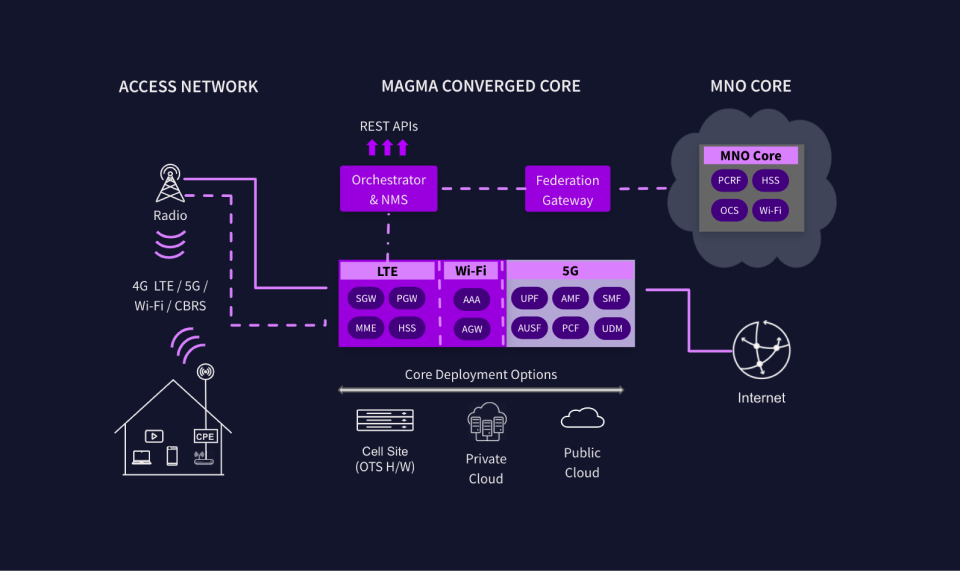Magma is designed to be 3GPP generation and access network (cellular or WiFi) agnostic. It can flexibly support a radio access network with minimal development and deployment effort.
Learn the technology
Magma architecture

3 major components
Access Gateway
The Access Gateway (AGW) provides network services and policy enforcement. In an LTE network, the AGW implements an evolved packet core (EPC), and a combination of an AAA and a PGW. It works with existing, unmodified commercial radio hardware.
Orchestrator
Orchestrator is a cloud service that provides a simple and consistent way to configure and monitor the wireless network securely. The Orchestrator can be hosted on a public/private cloud. The metrics acquired through the platform allows you to see the analytics and traffic flows of the wireless users through the Magma web UI.
Federation Gateway
The Federation Gateway integrates the MNO core network with Magma by using standard 3GPP interfaces to existing MNO components. It acts as a proxy between the Magma AGW and the operator’s network and facilitates core functions, such as authentication, data plans, policy enforcement, and charging to stay uniform between an existing MNO network and the expanded network with Magma.
Hardware and software compatibility
Access Gateway
Access gateways (AGWs) can be deployed on to any ARM64/AMD64 architecture machine which can support a Debian or Ubuntu 20.04 Linux installation.
Basic system requirements for the AGW production hardware
- 2+ physical Ethernet interfaces
- ARM64/AMD64 dual-core processor around 2GHz clock speed or faster
- 4GB RAM
- 32GB or greater SSD storage
Orchestrator & NMS
We recommend deploying the Orchestrator cloud component into AWS but it can also run on any public/private cloud with a Kubernetes cluster available.
Recommended components
- AWS account
- Registered domain for Orchestrator endpoints
RAN Equipment
All 3GPP compliant eNodeBs are supported.
eNodeB’s that have been tested
- Baicells Nova 233 TDD Outdoor
- Baicells Nova 243 TDD Outdoor
- Assorted Baicells indoor units (for lab deployments).
APIs & Standards
Technology Videos
Inside Magma
Explore how the three key components of Magma interact
with each other
Deploy Magma for FWA
Learn how to deploy Magma for Fixed Wireless Access
Networks
Develop for Magma
Be part of the evolution to a distributed network and join the community
Whitepapers
Mobile Data Offload (MDO)
As mobile data capacity demands continue to grow, MNOs and especially MVNOs are faced with greater competition and stagnant or falling revenue per subscriber. Mobile Data Offload (MDO) is an effective technique for addressing capacity needs in the face of congestion in cellular networks. The Plug-n-Play white paper demonstrates a way to do the core integration for seamless mobile Wi-Fi offload using a Plug-n-Play tested architecture.
Enabling Intelligent User-Oriented and Data Driven Traffic Steering
Magma Unified HetNet OpenSchema Data Lake is an open source effort to create a standard framework by defining a unified schema for metrics collection across all elements of the access network including User Equipment and radio equipment. This white paper will review multiple methods and approaches presented in academia and industry that address the problem of measuring network performance and improving Quality of Experience and Quality of Service metrics. We will explore HetNet use cases including:
- Seamless HetNet transition2 and UX improvement
- HetNet aggregation3
- Traffic/Application Predictive Steering
- Analytics for network asset positioning
- Handovers and Mobile Data Offload decision